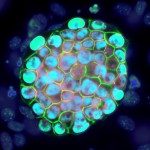Lien vers Pubmed [PMID] – 12884002
Hum. Genet. 2003 Sep;113(4):297-306
Myotubular/centronuclear myopathies are a nosological group of hereditary disorders characterised by severe architectural and metabolic remodelling of skeletal muscle fibres. In most myofibres, nuclei are found at an abnormal central position within a halo devoid of myofibrillar proteins. The X-linked form (myotubular myopathy) is the most prevalent and severe form in human, leading to death during early postnatal life. Maturation of fibres is not completed and fibres resemble myotubes. Linkage analysis in human has helped to identify MTM1 as the morbid gene. MTM1 encodes myotubularin, a dual protein phosphatase. In families in which myotubular myopathy segregates, detected mutations in MTM1 abolish the specific phosphatase activity targeting the second messenger phosphatidylinositol 3-phosphate. Autosomal forms (centronuclear) have a later onset and are often compatible with life. At birth, fibres are normally constituted but progressively follow remodelling with a secondary centralisation of nuclei. Their prevalence is low; hence, no linkage data can be performed and no molecular aetiology is known. In the Labrador Retriever, a spontaneous disorder strikingly mimics the clinical evolution of the human centronuclear myopathy. We have established a canine pedigree and show that the disorder segregates as an autosomal recessive trait in that pedigree. We have further mapped the dog locus to a region on chromosome 2 that is orthologous to human chromosome 10p. To date, no human MTM1 gene member has been mapped to this genetic region. This report thus describes the first spontaneous mammalian model of centronuclear myopathy and defines a new locus for this group of diseases.

